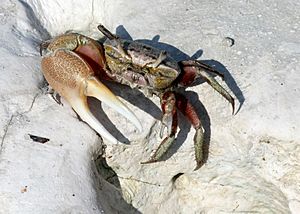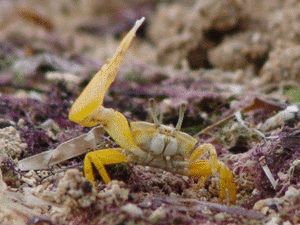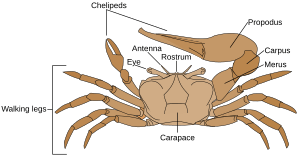Fiddler crab facts for kids
Quick facts for kids Fiddler crab |
|
|---|---|
 |
|
| Uca pugnax | |
| Scientific classification | |
| Kingdom: | |
| Phylum: | |
| Subphylum: | |
| Class: |
Malacostraca
|
| Order: |
Decapoda
|
| Infraorder: | |
| Family: |
Ocypodidae
|
| Genus: |
Uca
William Elford Leach, 1814
|
A fiddler crab, also called a calling crab, is a land crab that lives in mud or sand flats near the beach. The reason this crab is called a fiddler crab is because it holds its large cheliped in front of its body and moves it back and forth as if it is playing a fiddle.
Description
The male fiddler crab has one huge cheliped and another smaller cheliped. Sometimes it's the right cheliped that's the big one and sometimes it's the left. Like all crabs, fiddler crabs shed their shells as they grow. If they have lost legs or claws during their present growth cycle, a new one will be present when they molt. If the large fiddle claw is lost, males will develop one on the opposite side after their next molt. Newly molted crabs are very vulnerable because of their soft shells. They are reclusive and hide until the new shell hardens.
If a male loses its large cheliped, the smaller one will grow large to replace it. This huge cheliped is so large that it is sometimes bigger than the whole crab. It is this cheliped they wave back and forth.
Size
Fiddler crabs are considered small crabs. While there are many different species, the biggest one known is the West African fiddler crab (Afruca tangeri). Its body shell can be slightly over 2 inches (or about 5 cm) wide. Most other fiddler crab species are smaller than that.
Ecology
Found in mangroves, in salt marshes, and on sandy or muddy beaches of West Africa, the Western Atlantic, the Eastern Pacific, Indo-Pacific and Algarve region of Portugal, fiddler crabs are easily recognized by their distinctively asymmetric claws. The males' major claw is much larger than the minor claw, while the females' claws are both the same size.
Fiddler crabs communicate by a sequence of waves and gestures; males have an oversized claw or chela; used in clashes of ritualised combat of courtship over a female and signal their intentions between conspecifics. The movement of the smaller claw from ground to mouth during feeding explains the crabs' common name; it looks as if the animal were playing the larger claw like a fiddle.
The crab's smaller claw picks up a chunk of sediment from the ground and brings it to the mouth, where its contents are sifted through (making the crab a detritivore). After anything edible is salvaged, be it algae, microbes, fungus, or other decaying detritus, the sediment is replaced in the form of a little ball. The presence of these sediment balls near the entrance to a burrow is a good indication of its occupation. Some experts believe that the feeding habits of fiddler crabs play a vital role in the preservation of wetland environments; by sifting through the sands, they aerate the substrate and prevent anaerobic conditions.
Fiddler crab's diet
The fiddler crab eats by first opening its mouth, then using its maxillipeds (a part of its mouth), it scoops in a small amount of mud or sand, depending on where it lives. Then, it uses its other mouthparts to scrape any food matter (algae, decaying animals or plants)it can from the dirt it has just put into its mouth. After this, it forms the mud or sand into a little pellet, which is called a feeding pellet. It then drops the feeding pellet and starts all over again.
Life cycle
Fiddler crabs live rather brief lives of no more than two years (up to three years in captivity). Male fiddler crabs use the major claw to perform a waving display as a form of female courtship. Females choose their mate based on claw size and also quality of the waving display. In many fiddler crab species, the female occupies the burrow of their mate while she lays her clutch of eggs.
Research shows that the male major claw size is also correlated with burrow width; the width of the burrow influences incubation temperature. Therefore, the female will choose a male mate whose claw size indicates the best burrow environment for her clutch of eggs. The waving display is also thought to indicate to females the overall healthiness of the male; a more vigorous display is more difficult to do and thus requires the male to be in prime health condition, which suggests that the male will help produce viable offspring.
Male versus male competition also occurs as fighting with the major claws. If a male loses his larger claw, the smaller one will begin to grow larger and the lost claw will regenerate into a new (small) claw. For at least some species of fiddler crabs, however, the small claw remains small, while the larger claw regenerates over a period of several molts, being about half its former size after the first molt. The female fiddler carries her eggs in a mass on the underside of her body. She remains in her burrow during a two-week gestation period, after which she ventures out to release her eggs into the receding tide. The larvae remain planktonic for a further two weeks.
Fiddler crabs such as Uca mjoebergi have been shown to bluff about their fighting ability. Upon regrowing a lost claw, a crab will occasionally regrow a weaker claw that nevertheless intimidates crabs with smaller but stronger claws. This is an example of dishonest signalling.
The dual functionality of the major claw of fiddler crabs has presented an evolutionary conundrum in that the claw mechanics best suited for fighting do not match up with the mechanics best suited for a waving display.
Captivity
Fiddler crabs are occasionally kept as pets. The fiddler crabs sold in pet stores generally come from brackish water lagoons. Because they live in lower salinity water, pet stores may call them fresh-water crabs, but they cannot survive indefinitely in fresh water. Fiddler crabs have been known to attack small fish in captivity, as opposed to their natural feeding habits.
See also
 In Spanish: Cangrejo violinista para niños
In Spanish: Cangrejo violinista para niños



